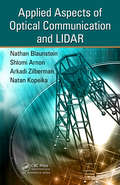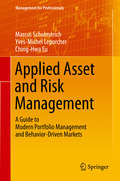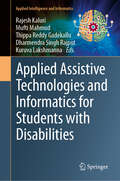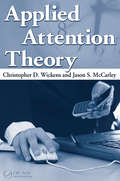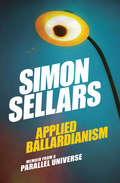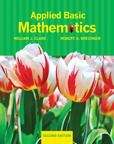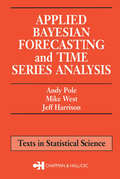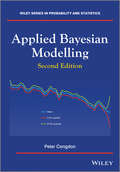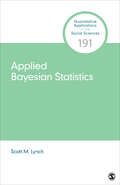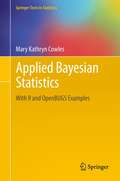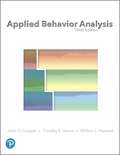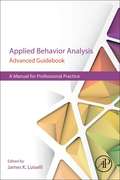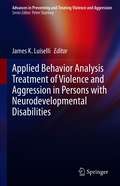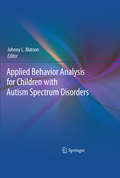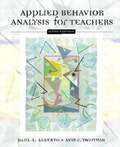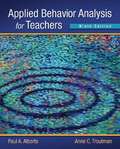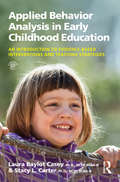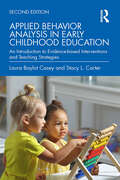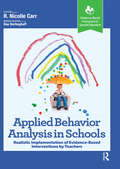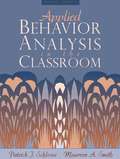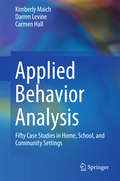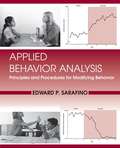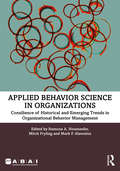- Table View
- List View
Applied Aspects of Optical Communication and LIDAR
by Nathan Blaunstein Shlomi Arnon Natan Kopeika Arkadi ZilbermanExploring the practical aspects of atmospheric optical communication and light detection and ranging (LIDAR), Applied Aspects of Optical Communication and LIDAR details the role of atmospheric structures in propagation phenomena that influence the transmission of optical signals through perturbed atmospheric communication channels. It examines nume
Applied Asset and Risk Management: A Guide to Modern Portfolio Management and Behavior-Driven Markets (Management for Professionals)
by Marcus Schulmerich Yves-Michel Leporcher Ching-Hwa EuThis book is a guide to asset and risk management from a practical point of view. It is centered around two questions triggered by the global events on the stock markets since the middle of the last decade: - Why do crashes happen when in theory they should not? - How do investors deal with such crises in terms of their risk measurement and management and as a consequence, what are the implications for the chosen investment strategies? The book presents and discusses two different approaches to finance and investing, i. e. , modern portfolio theory and behavioral finance, and provides an overview of stock market anomalies and historical crashes. It is intended to serve as a comprehensive introduction to asset and risk management for bachelor's and master's students in this field as well as for young professionals in the asset management industry. A key part of this book is the exercises to further demonstrate the concepts presented with examples and a step-by-step business case. An Excel file with the calculations and solutions for all 17 examples as well as all business case calculations can be downloaded at extras. springer. com.
Applied Assistive Technologies and Informatics for Students with Disabilities (Applied Intelligence and Informatics)
by Mufti Mahmud Rajesh Kaluri Thippa Reddy Gadekallu Dharmendra Singh Rajput Kuruva LakshmannaThe book “Applied Assistive Technologies and Informatics for Students with Disabilities” provides a comprehensive guide to assist students with learning disabilities in higher education via modern assistive technologies and informatics. This book will take us on a tour of the various modern assistive technologies, such as artificial intelligence (AI), blockchain, computer vision (CV), text analytics (TA), the metaverse, human-computer interaction (HCI), digital twins (DT), and federated learning (FL), and how they support higher education students with learning disabilities. This book is intended for students with learning disabilities, scientists and researchers, lecturers and teachers, academic and corporate libraries, practitioners, and professionals who are interested in providing inclusive education to students with learning disabilities through the application of modern assistive technologies and informatics. This book is ideal for readers who are new to the subject and knowledgeable about the principles of inclusive education. In addition, it is a fantastic resource for teachers and parents assisting students with learning disabilities. This book can be a powerful tool to educate more students about learning disabilities, which can help eradicate the bullying of these students.
Applied Attention Theory
by Christopher D. Wickens Jason S. McCarleyEye witness testimony, training, driving, and display design: these are just a few of the real-world domains in which depend on undivided attention. Emphasizing the link between theory and application, Applied Attention Theory provides a deep understanding of how theories of attention, developed from laboratory-based psychological research, can inform our understanding of everyday human performance in a wide number of applications and environments. The basic theories discussed concern divided, focused, and selective attention, and areas of application include mental workload measurement, multi-tasking, distracted driving, complex display design, education, and the training of attentional skills. Includes an extensive reference list and citations to both basic and applied work Provides intuitive descriptions of attentional phenomena in the world beyond the laboratory Discusses applications of attention theory to diverse areas such as graph design, distracted driving, and process control Offers an engineering orientation as well as a psychological orientation to research Highlights the critical role of effort in single task behavior, such as decision and choice, to the extent that humans tend to be effort-conserving in their choice of activities Examines how multiple tasks are managed in a discrete fashion
Applied Attention Theory
by Christopher D. Wickens Jason S. McCarley Robert S. GutzwillerApplied Attention Theory, Second Edition provides details concerning the relevance of all aspects of attention to the world beyond the laboratory. Topic application areas include the design of warning systems to capture attention; attention distractions in the workplace; failures of dividing attention while driving; and the measurement of mental workload while flying. This new edition discusses the implications of VR and AR for human attention. It also covers the treatment of attention-based pedagogical methods used to enhance learning and presents attentional issues in interacting with automation and AI. New chapters include applications of attention to healthcare, education pedagogy, highway safety, and human interaction with autonomous vehicles and other AI systems. The readership for this book is the professional, the researcher, and the student.
Applied Ballardianism: Memoir from a Parallel Universe (Urbanomic / K-Pulp #1)
by Simon SellarsAn existential odyssey weaving together lived experience and theoretical insight, this startling autobiographical hyperfiction surveys and dissects a world where everything connects and global technological delirium is the norm.The mediascapes of late capitalism reconfigure erotic responses and trigger primal aggression; under constant surveillance, we occupy simulations of ourselves, private estates on a hyperconnected globe; fictions reprogram reality, memories are rewritten by the future…Fleeing the excesses of 1990s cyberculture, a young researcher sets out to systematically analyse the obsessively reiterated themes of a writer who prophesied the disorienting future we now inhabit. The story of his failure is as disturbingly psychotropic as those of his magus—J.G. Ballard, prophet of the post-postmodern, voluptuary of the car crash, surgeon of the pathological virtualities pulsing beneath the surface of reality.Plagued by obsessive fears, defeated by the tedium of academia, yet still certain that everything connects to Ballard, his academic thesis collapses into a series of delirious travelogues, deranged speculations and tormented meditations on time, memory, and loss. Abandoning literary interpretation and renouncing all scholarly distance, he finally accepts the deep assignment that has run throughout his entire life, and embarks on a rogue fieldwork project: Applied Ballardianism, a new discipline and a new ideal for living. Only the darkest impulses, the most morbid obsessions, and the most apocalyptic paranoia can uncover the technological mutations of inner space.An existential odyssey inextricably weaving together lived experience and theoretical insight, this startling autobiographical hyperfiction surveys and dissects a world where everything connects and global technological delirium is the norm—a world become unmistakably Ballardian.
Applied Basic Mathematics
by William Clark Robert A. BrechnerWith an emphasis on real world applications, Applied Basic Mathematics, Second Edition, provides students with a new and refreshing perspective on basic math. Paired with a system of structured support, authors Clark and Brechner consistently asks student to relate, reinforce, and review as they learn. This text provides professors with a dynamic way of teaching the material and an approach that encourages students to dive into the math!
Applied Bayesian Forecasting and Time Series Analysis
by Andy Pole Mike West Jeff HarrisonPractical in its approach, Applied Bayesian Forecasting and Time Series Analysis provides the theories, methods, and tools necessary for forecasting and the analysis of time series. The authors unify the concepts, model forms, and modeling requirements within the framework of the dynamic linear mode (DLM). They include a complete theoretical development of the DLM and illustrate each step with analysis of time series data. Using real data sets the authors: Explore diverse aspects of time series, including how to identify, structure, explain observed behavior, model structures and behaviors, and interpret analyses to make informed forecasts Illustrate concepts such as component decomposition, fundamental model forms including trends and cycles, and practical modeling requirements for routine change and unusual events Conduct all analyses in the BATS computer programs, furnishing online that program and the more than 50 data sets used in the text The result is a clear presentation of the Bayesian paradigm: quantified subjective judgements derived from selected models applied to time series observations. Accessible to undergraduates, this unique volume also offers complete guidelines valuable to researchers, practitioners, and advanced students in statistics, operations research, and engineering.
Applied Bayesian Modelling
by Peter CongdonThis book provides an accessible approach to Bayesian computing and data analysis, with an emphasis on the interpretation of real data sets. Following in the tradition of the successful first edition, this book aims to make a wide range of statistical modeling applications accessible using tested code that can be readily adapted to the reader's own applications. The second edition has been thoroughly reworked and updated to take account of advances in the field. A new set of worked examples is included. The novel aspect of the first edition was the coverage of statistical modeling using WinBUGS and OPENBUGS. This feature continues in the new edition along with examples using R to broaden appeal and for completeness of coverage.
Applied Bayesian Statistics (Quantitative Applications in the Social Sciences)
by Scott M. LynchBayesian statistical analyses have become increasingly common over the last two decades. The rapid increase in computing power that facilitated their implementation coincided with major changes in the research interests of, and data availability for, social scientists. Specifically, the last two decades have seen an increase in the availability of panel data sets, other hierarchically structured data sets including spatially organized data, along with interests in life course processes and the influence of context on individual behavior and outcomes. The Bayesian approach to statistics is well-suited for these types of data and research questions. Applied Bayesian Statistics is an introduction to these methods that is geared toward social scientists. Author Scott M. Lynch makes the material accessible by emphasizing application more than theory, explaining the math in a step-by-step fashion, and demonstrating the Bayesian approach in analyses of U.S. political trends drawing on data from the General Social Survey.
Applied Bayesian Statistics (Quantitative Applications in the Social Sciences)
by Scott M. LynchBayesian statistical analyses have become increasingly common over the last two decades. The rapid increase in computing power that facilitated their implementation coincided with major changes in the research interests of, and data availability for, social scientists. Specifically, the last two decades have seen an increase in the availability of panel data sets, other hierarchically structured data sets including spatially organized data, along with interests in life course processes and the influence of context on individual behavior and outcomes. The Bayesian approach to statistics is well-suited for these types of data and research questions. Applied Bayesian Statistics is an introduction to these methods that is geared toward social scientists. Author Scott M. Lynch makes the material accessible by emphasizing application more than theory, explaining the math in a step-by-step fashion, and demonstrating the Bayesian approach in analyses of U.S. political trends drawing on data from the General Social Survey.
Applied Bayesian Statistics: With R and OpenBUGS Examples (Springer Texts in Statistics #98)
by Mary Kathryn CowlesThis book is based on over a dozen years teaching a Bayesian Statistics course. The material presented here has been used by students of different levels and disciplines, including advanced undergraduates studying Mathematics and Statistics and students in graduate programs in Statistics, Biostatistics, Engineering, Economics, Marketing, Pharmacy, and Psychology. The goal of the book is to impart the basics of designing and carrying out Bayesian analyses, and interpreting and communicating the results. In addition, readers will learn to use the predominant software for Bayesian model-fitting, R and OpenBUGS. The practical approach this book takes will help students of all levels to build understanding of the concepts and procedures required to answer real questions by performing Bayesian analysis of real data. Topics covered include comparing and contrasting Bayesian and classical methods, specifying hierarchical models, and assessing Markov chain Monte Carlo output. Kate Cowles taught Suzuki piano for many years before going to graduate school in Biostatistics. Her research areas are Bayesian and computational statistics, with application to environmental science. She is on the faculty of Statistics at The University of Iowa.
Applied Behavior Analysis
by William L. Heward John O. Cooper Timothy E. HeronThis text provides an accurate, comprehensive, and contemporary description of applied behavior analysis in order to help readers acquire fundamental knowledge and skills. Applied Behavior Analysis provides a comprehensive, in-depth discussion of the field, offering a complete description of the principles and procedures for changing and analyzing socially important behavior. The 3rd Edition features coverage of advances in all three interrelated domains of the sciences of behavior–theoretical, basic research, and applied research–and two new chapters, Equivalence-based Instruction (Ch. 19) and Engineering Emergent Learning with Nonequivalence Relations (Ch. 20). It also includes updated and new content on topics such as negative reinforcement (Ch. 12), motivation (Ch. 16), verbal behavior (Ch. 18), functional behavioral assessment (Ch. 27), and ethics (Ch. 31).
Applied Behavior Analysis Advanced Guidebook: A Manual for Professional Practice
by James K. LuiselliThe Applied Behavior Analysis Practice Guidebook: A Manual for Professional Practice gives behavioral practitioners pragmatic advice, direction and recommendations for being an effective clinician, consultant, supervisor and performance manager. The book adopts a how to do it perspective featuring contributions from expert scientist-practitioners. Each chapter introduces the relevance of the topic for practicing professionals, describes and synthesizes the empirical basis of the topic, and then presents practitioner recommendations. With this format, readers can navigate the chapters with familiarity and confidence to facilitate the understanding of content and integration of the many practice areas addressed.
Applied Behavior Analysis Treatment of Violence and Aggression in Persons with Neurodevelopmental Disabilities (Advances in Preventing and Treating Violence and Aggression)
by James K. LuiselliThis book focuses on applied behavior analysis (ABA) treatment of violence and aggression in persons with neurodevelopmental disabilities. It details ABA theory and concepts leading to empirical treatment procedures that can be implemented successfully across diverse treatment settings. Further, the book examines contemporary approaches to functional behavioral assessment (FBA) and functional analysis (FA) in determining the environmental conditions responsible for violence and aggression. In addition, the volume describes several evidence-supported treatment procedures that encompass antecedent-control, contingency management, cognitive-behavior therapy, and physical intervention components. It addresses effective strategies for training and supervising care providers, including behavioral skills training (BST), posttraining performance management, and mindfulness. Finally, the book presents recommendations that guide effective and socially valid research-to-practice translation. Applied Behavior Analysis Treatment of Violence and Aggression in Persons with Neurodevelopmental Disabilities is an essential resource for researchers, clinicians/therapists, and upper-level undergraduate and graduate students in forensic psychology, public health, criminology/criminal justice, and behavioral therapy and rehabilitation.
Applied Behavior Analysis for Children with Autism Spectrum Disorders
by Johnny L. MatsonAutism was once thought of as a rare condition, until the Centers for Disease Control and Prevention's Autism and Developmental Disabilities Monitoring Network released the statistic that about 1 in every 150 eight-year-old children in various areas across the United States is afflicted by an autism spectrum disorder, or ASD. This news led to a dramatic expansion of research into autism spectrum disorders and to the emergence of applied behavior analysis (ABA) as the preferred method of treatment, even among prescribing practitioners. Applied Behavioral Analysis for Children with Autism Spectrum Disorders ably synthesizes research data and trends with best-practice interventions into a comprehensive, state-of-the-art resource. Within its chapters, leading experts review current ABA literature in depth; identify interventions most relevant to children across the autism spectrum; and discuss potential developments in these core areas: Assessment methods, from functional assessment to single case research designs. Treatment methods, including reinforcement, replacement behaviors, and other effective strategies. The role of the differential diagnosis in ABA treatment planning. Specific deficit areas: communication, social skills, stereotypies/rituals. Target behaviors, such as self-injury, aggression, adaptive and self-help problems. ASD-related training concerns, including maintenance and transition issues, and parent training programs. This volume is a vital resource for researchers, graduate students, and professionals in clinical child and school psychology as well as the related fields of education and mental health.
Applied Behavior Analysis for Teachers
by Paul A. Alberto Anne C. TroutmanThis text explains behavior theory and teaches aspiring educators how to apply it to classroom settings.
Applied Behavior Analysis for Teachers
by Paul A. Alberto Anne C. TroutmanThe market-leading book Applied Behavior Analysis for Teachers gives you what you need to understand to use the principles and practices of applied behavior analysis in the classroom. The content is presented clearly, in a friendly, accessible-even fun-manner. The ninth edition uses classroom-based examples and practices firmly grounded in research. Content is presented in the order of decision-making by a teacher who has a student exhibiting challenging behavior in class or a student who needs to execute a behavior-change project. The text covers identifying target behavior, collecting and graphing data, functional assessment, experimental design, arranging antecedents and consequences, and generalizing behavior change. The importance of ethical considerations in using applied behavior analysis in the classroom is now presented at the beginning of the book to highlight the importance of applying principles and practices responsibly.
Applied Behavior Analysis in Early Childhood Education: An Introduction to Evidence-based Interventions and Teaching Strategies
by Laura Baylot Casey Stacy L. CarterApplied Behavior Analysis in Early Childhood Education provides a basic introduction to applied behavior analysis and the highly beneficial role that it can play in early childhood education for both typically developing children and those with special needs. The objective is to provide future and current early childhood professionals with the tools that they need to positively impact the lives of young children. Specifically, the book will describe and provide useful examples related to the following: Implementing effective techniques for changing behavior; Strategies for every day challenges both in the classroom and at home; Strategies for addressing less frequent issues; Suggestions for how to consult and correspond with parents and caretakers. Applied Behavior Analysis in Early Childhood Education is written for professionals preparing for—or those already in—careers in child development, behavior analysis, early childhood education, developmental therapy, counseling, special education, and other helping professions. A Companion Website featuring additional information and resources for students and instructors can be accessed at www.routledge.com/cw/casey.
Applied Behavior Analysis in Early Childhood Education: An Introduction to Evidence-based Interventions and Teaching Strategies
by Laura Baylot Casey Stacy L. CarterApplied Behavior Analysis in Early Childhood Education provides a basic introduction to applied behavior analysis and overviews the highly beneficial role that it can play in early childhood education for both typically developing children and those with special needs. This updated text equips future and current early childhood professionals with the tools they need to positively impact the lives of young children, including how to implement effective techniques for changing behavior, strategies for everyday challenges both in the classroom and at home, and suggestions for how to consult and correspond with parents and caretakers. The book is ideal for professionals preparing for—or those already in—careers in child development, behavior analysis, early childhood education, developmental therapy, counseling, and special education. A companion website provides further information and resources for students and instructors.
Applied Behavior Analysis in Schools: Realistic Implementation of Evidence-Based Interventions by Teachers (Evidence-Based Instruction in Special Education)
by R. CarrMost applied behavior analysis (ABA) texts rely heavily on research findings and technical theory, making them inaccessible for use by everyday teachers. Applied Behavior Analysis in Schools: Realistic Implementation of Evidence-Based Interventions by Teachers aims to be the missing link between books on classroom interventions within teacher preparation programs. Dr. R. Nicolle Carr leverages her years of expertise with ABA and channels it into creating practical, realistic working models of ABA that any teacher can use. Her “by teachers, for teachers” approach to writing effectively outlines ABA strategies so that they can be used with few resources and minimal training. Applied Behavior Analysis in Schools is tailored toward future and current educators to enable them to learn invaluable tools like how to effectively take data in a classroom to help with academic performance or behavior management—without requiring them to possess a background in ABA. What’s included in Applied Behavior Analysis in Schools:• Chapters on Acceptance and Commitment Therapy• The role of cultural considerations and collaboration skills• Use of ABA in transition skills• Applying ABA to academics and an overview of assessmentsIncluded with the text are online supplemental materials for faculty use in the classroom. Applied Behavior Analysis in Schools: Realistic Implementation of Evidence-Based Interventions by Teachers takes the concepts of ABA and presents them to teachers in a way that is both approachable and applicable.
Applied Behavior Analysis in the Classroom (Second Edition)
by Patrick J. Schloss Maureen A. SmithWritten for professionals in both general and special education, this book is a complete description of applied behavior analysis and how it can be used with students displaying a range of behaviors.
Applied Behavior Analysis: Fifty Case Studies in Home, School, and Community Settings
by Darren Levine Kimberly Maich Carmen HallThis textbook offers real-world case studies for using Applied Behavior Analysis (ABA) to create, implement, and appraise behavior intervention programs across a variety of client situations. Its chapters are formatted for ease of use and retention and organized to focus on the core components of ABA: assessment, planning, implementation, evaluation, and research/ethics. Illustrative cases represent a diversity of problem behaviors, settings, social contexts, and life stages, and includes questions about data collection, goal setting, communication with families, and other processes of effective ABA practice. Together they emphasize not only the content knowledge involved in designing interventions, but also the interpersonal skills necessary for helping change complex challenging behaviors. These fifty case studies: Are suited to individual or team training. Present guiding questions regarding ABA process and professional practice. Feature charts, forms, templates, and other practical tools. Include links to Behavior Analyst Certification Board resources. Demonstrate the flexibility of ABA for use with children, adolescents, adults, or seniors. Applied Behavior Analysis: Fifty Case Studies in Home, School, and Community Settings is an essential text for graduate students, researchers, and practitioners in child and school psychology, behavior analysis, learning and instruction, counseling, and education. This singular volume models critical thinking and professional development in keeping with best practices and professional standards.
Applied Behavior Analysis: Principles and Procedures for Modifying Behavior
by Edward P. SarafinoSarafino's goal in Principles and Procedures for Modifying Behavior is to create a clear and engaging instrument that describes ways to analyze one's own specific behaviors in terms of the factors that lead to and maintain them and ways to manage those factors to improve the behaviors. The text is based on research, theory, and experiences to explain and provide examples of the concepts and methods of self-management in a comprehensive text. It focuses on topics in applied behavior analysis, behavior modification, behavior therapy, and psychology of learning. Two general topics shaped this text: making the book relative to a variety of fields by describing applications in psychology, education, counseling, nursing, and physical therapy and different academic levels and preparation. Several important objectives guided the content and organization of the text which is designed to cover a large majority of tasks or concepts that the Behavior Analyst Certification Board (www. bacb. com) has identified as the field's essential content and should be mastered by all behavior analysts.
Applied Behavior Science in Organizations: Consilience of Historical and Emerging Trends in Organizational Behavior Management (Behavior Science)
by Ramona A. Houmanfar Mitch Fryling Mark P. AlavosiusApplied Behavior Science in Organizations provides a compelling overview of the history of Organizational Behavior Management (OBM) and the opportunity it presents for designing and managing positive work environments that can in turn have a positive impact on society. The book brings together leading experts from industry and research settings to provide an overview of the historical approaches in Organizational Behavior Management. It begins with an introduction to recognized practices in OBM and the applications of fundamental principles of behavior analysis to a variety of performance problems in organizational settings. The book then highlights how organizational practices and consumers’ behavior combine in a complex confluence to meet an organization’s goals and satisfy consumer appetites, whilst often unintentionally affecting the wellbeing of organizational members. It argues that the science of behavior has a responsibility to contribute to the safety, health and wellbeing of organizational members, consumers of organizational products, and beyond. Finally, the book recognizes the essential role of organizations in initiating, shaping, and sustaining the development of more nurturing and reinforcing work environments, through discussion of the need for innovation while adapting and responding to growing social upheaval, technological advances, and environmental concerns, alongside crises in the global economy, health, education, and environment. Showcasing emerging work by internationally recognized scholars on the application of behavior science in organizations, the book will be an essential read for all students and professionals of Organizational Behavior Management, as well as those interested in using organizational applications to create new models of management.
